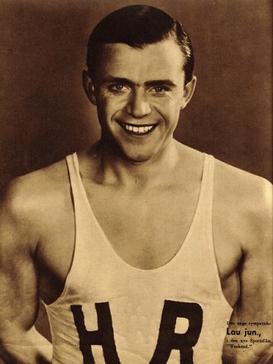
Ole Christensen Rømer was a Danish astronomer who, in 1676, made the first measurement of the speed of light.

Ryvangen Memorial Park is a memorial park in Ryvangen officially inaugurated on 5 May 1950 to commemorate fallen members of the Danish resistance to the German occupation of Denmark during World War II.
Saga Studio was a film production company in Denmark founded by John Olsen. The company existed from 1942 to 1976.

Lau Lauritzen Jr., was a Danish actor, screenwriter, and film director. As a director, he was a 4-time recipient of the Bodil Award for Best Danish Film. Lauritzen co-founded the Danish film studio ASA Film and served as the studio's artistic director (1937–1945) and administrative director (1945–1964).
Per Buckhøj was a Danish film actor. He appeared in 36 films between 1942 and 1958.
Preben Lerdorff Rye was a Danish film actor. He appeared in 92 films between 1941 and 1989. He was born and died in Denmark.

De Gyldne Laurbær is a Danish literature award, which was established in 1949. The award is handed by The Committee De Gyldne Laurbær, formerly Boghandlerklubben. The prize is given annually in February or March. Originally the award was a laurel wreath, a golden pin with an inscription, some money and a book gift worth 2500 DKK. Today the award is a laurel wreathe, a diploma and a book gift worth 2500 DKK. The award is handed at a ceremony arranged by the publishing house which has published the winning book and by the Committee De Gyldne Laurbær. Early in January every year the committee sends out ballot to all the Danish bookshops, which then give their vote for a Danish book which was published the year before. An author can only win The Golden Laurel once-in-a-lifetime, so the bookshops can not vote for an author who has already won the prize once before. The winner is usually one of the bestsellers among the Danish books. On the day when it is decided who wins the Golden Laurel, the president of the Committee of The Golden Laurel informs the winner about the award, while journalists follow the event.
The Danish Critics Prize for Literature is an annual Danish literature award. It was established in 1957 by the Danish Publishers Association. Since 1971 the award has been made by the Danish Literature Critics Association after a vote by members. The award currently carries a prize of DKK 30,000. The Association also awards the Georg Brandes-Prize.
The Holberg Medal is an award to a Danish author of fiction or writer on science. It is an appreciation of a literary or scientific work or of the award winner's authorship as a whole. The prize is often awarded on 3 December, the birthday of Ludvig Holberg. The first award was given in 1934 in connection with the 40th anniversary of the Danish association of authors.
Karl Gustav Stricker Brøndsted was a member of the Danish resistance executed by the German occupying power.
Harald Christensen was a member of the Danish resistance executed by the German occupying power.
Gudrun Fiil was inn keeper at Hvidsten Inn and member of the Danish resistance, whose husband, son and son-in-law were executed by the German occupying power.

Erik Crone was a member of the Danish resistance executed by the German occupying power.
Svend Glendau was a member of the Danish resistance executed by the German occupying power.
Andreas Bronislaw Wadeksloff Nielsen was a member of the Danish resistance executed by the German occupying power.
Preben Gylche was a member of the Danish resistance executed by the German occupying power and son of Karl Paul Kristian Gylche.
FBUs Pokalturnering was a Danish regional knockout association football competition contested annually from 1920 to 1953 by members of the regional football association Funen FA (FBU). Organised by and named after FBU, it was the third regional cup competition introduced on a national level, and the second in the province, after the KBUs Pokalturnering in 1910 and the LFBUs Pokalturnering in 1915. The 1953 season of the cup tournament became the last edition due to the Danish FA's introduction of a new national-wide cup competition in 1954.
A/S Palladium was a Danish film production company which existed from 1919 to 2017.

The 1928 Provinsmesterskabsturneringen i Fodbold was the 15th edition of the Danish provincial championship play-off, Provinsmesterskabsturneringen, the second highest senior cup competition, crowning the best provincial championship club of the five regional football associations outside the dominating Copenhagen football clubs, organised and financially supported by the national football organization Danish FA (DBU). This was the first edition of the tournament under its new status as a separate championship cup tournament, no longer being an essential part of the road to winning the Danish Football Championship, which it had been under the previous structure of Landsfodboldturneringen. The new Danish Football Championship structure, had its debut this season, 1927–28 Danmarksmesterskabsturneringen. Following a recommendation by the five provincial football associations, the Danish FA finally decided to re-establish a provincial football tournament in late March 1928.

The Cotillion Coach is a miniature coach constructed in 1888 for the celebration of the 70th birthday of Christian IX of Denmark. It was later refurbished for the celebrations of the 18th birthday of Margrethe II and once again used at the 70th birthday of Queen Ingrid. It is on display in the Royal Mews and Carriage Museum at Christiansborg Palace in Copenhagen.








